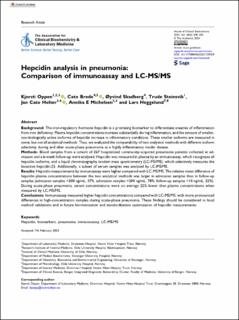Hepcidin analysis in pneumonia: Comparison of immunoassay and LC-MS/MS
Oppen, Kjersti; Brede, Cato; Skadberg, Øyvind; Steinsvik, Trude; Holter, Jan Cato; Michelsen, Annika Elisabet; Heggelund, Lars
Peer reviewed, Journal article
Published version

Permanent lenke
https://hdl.handle.net/11250/3104091Utgivelsesdato
2023Metadata
Vis full innførselSamlinger
Originalversjon
Oppen, K., Brede, C., Skadberg, Ø., Steinsvik, T., Holter, J. C., Michelsen, A. E., & Heggelund, L. (2023). Hepcidin analysis in pneumonia: Comparison of immunoassay and LC-MS/MS. Annals of Clinical Biochemistry, 60(5), 00045632231159529. 10.1177/00045632231159529Sammendrag
Background
The iron-regulatory hormone hepcidin is a promising biomarker to differentiate anaemia of inflammation from iron deficiency. Plasma hepcidin concentrations increase substantially during inflammation, and the amount of smaller, non-biologically active isoforms of hepcidin increase in inflammatory conditions. These smaller isoforms are measured in some, but not all analytical methods. Thus, we evaluated the comparability of two analytical methods with different isoform selectivity during and after acute-phase pneumonia as a highly inflammatory model disease.
Methods
Blood samples from a cohort of 267 hospitalized community-acquired pneumonia patients collected at admission and a 6-week follow-up were analysed. Hepcidin was measured in plasma by an immunoassay, which recognizes all hepcidin isoforms, and a liquid chromatography tandem mass spectrometry (LC-MS/MS), which selectively measures the bioactive hepcidin-25. Additionally, a subset of serum samples was analysed by LC-MS/MS.
Results
Hepcidin measurements by immunoassay were higher compared with LC-MS/MS. The relative mean difference of hepcidin plasma concentrations between the two analytical methods was larger in admission samples than in follow-up samples (admission samples <200 ng/mL: 37%, admission samples >200 ng/mL: 78%, follow-up samples >10 ng/mL: 22%). During acute-phase pneumonia, serum concentrations were on average 22% lower than plasma concentrations when measured by LC-MS/MS.
Conclusions
Immunoassay measured higher hepcidin concentrations compared with LC-MS/MS, with more pronounced differences in high-concentration samples during acute-phase pneumonia. These findings should be considered in local method validations and in future harmonization and standardization optimization of hepcidin measurements.
